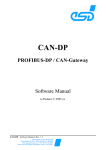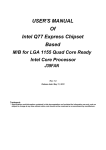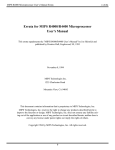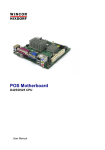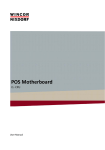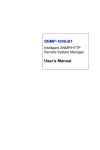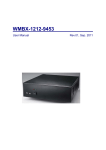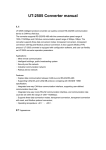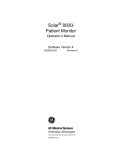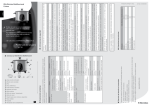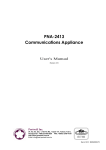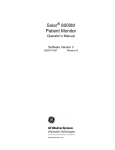Download EBC 569 Series - IPC2U GmbH - Industrial PC, Industrie PC
Transcript
www.nexcom.com The DigitalInfrastructure CPU Board EBC 569 Series User's Manual EBC 569 User‘s Guide Rev. B0 Chapter 1 Introduction and Specifications 5.25" Pentium® III Level New Embedded Engine Is Ideal For New Generation of POS Kiosk EBC 569,a new Pentium® III-based embedded CPU board, and claimed that it is a powerful engine for the new generation of multimedia, networked, and panel-based POS (Point Of Sales) machines. This kind of POS, kiosks, or even game machines will deliver EBC 569 vivid audio/video streams, quick responses, and real-time updates to and from local or remote servers. For high sales seasons, definitely need the best POS machines to attract more customers and process more transactions with the same or even lower investment. The EBC 569, with the powerful on board, surfacemounted Pentium III compatible CPU, the richest built-in features, and various conventional specs like SIO x4, PC 104, etc. all included, it will boost the POS kiosk and game machines to new heights. The EBC 569 specifications are as follows: ?? CPU: C3 EBGA CPU, up to 800MHz, 133MHz FSB or VIA Eden series ultra low power CPU without fan support ?? Memory: 512 MB SDRAM (max.), DIMMx1, PC 133 spec. ?? Chipset: VIA 8606 (Twister T) ?? VGA: S3 Savage4 on Die, 4X AGP, 2D/3D support, 32 MB shared Frame Buffer, TTL/ LVDS interface to Panels ?? Audio: AC 97 compliant ?? LAN: 10/ 100 Base T Ethernet port x2 Introduction 1 -1 EBC 569 User‘s Guide Rev. B0 ?? Compact Flash connector x1 ?? I/O: SIO x4, PIO x1, USB x2, FDD, IDE,¡K ?? Bus: PC 104 x1, PCI slot x1 ?? Form Factor: 5.25" Drive foot print, 203mm x 143mm The computing power, the audio/video capabilities, and the connectivity have become a basic requirement for the new generation of POS machines, which means a Pentium III class of CPU is a must for the computing functions. The trend of feeding video streams through the network to the POS/POI (Point of Information) machines is now growing very fast. The 3D graphics, or even videos are very popular on game machines. The DVD quality, or more specifically the MPEG II decoding capability, given that it has already become a standard in the consumer world, is also a growing trend. People just can't live without it! The traditional embedded solutions offered to answer these growing needs just seem a little bit awkward. People use the discrete chips for the solutions; the Intel Pentium III CPU, with the additional VGA chip supporting panels that have higher performance (which is still not enough), they are either too expensive or far below the performance required. However, with NEXCOM's EBC 569, we use the low power yet high performance C3 CPU with the same process as the Tualatin CPU (.13u), and up to 800 MHz (1GHz in the near future), plus the chip set built with the H/W core from S3 Savage4 4X AGP video controller, 3D capability, and 32 MB shared frame buffer. This is the new generation, highly integrated, and cost effective computing platform for the embedded world. It just fits perfectly! With the CPU performance growing steadily on the same design, it's a platform that promises a long term superiority. For applications that prefer low power to high performance, the EBC 569 will be able to use the ultra low power series of Eden CPUs starting from 400 MHz up to 667 MHz in the near future; and for the 400 MHz version specifically, there is no need of a cooling fan on the CPU, the only requirement is for the whole chassis solution can provide the air flow to remove the heat. Introduction 1 -2 EBC 569 User‘s Guide Rev. B0 Specification: ?? 5.25” small form factor with Dimensions: 203mm(L) ? 143mm(W) ?? PCB : 6 Layer with double side ?? On Board CPU ?? Onboard VIA C3 Processor EBGA Package with 128KB Level 1 and 64KB Level 2 Cache ?? 800MHZ CPU on board, a nd feature VIA C3 series CPU with EBGA Package ?? CPU FSB 100/133MHZ ?? CPU FANless feature By VIA Eden Series Ultra Low Power CPU and Chassis air flow. ?? Main Memory ?? One 168-pin DIMM. Support Max memory size to 512MB ?? BIOS ?? Award System BIOS ?? Advanced Power Management support ?? Optional ACPI Support ?? 4M bits flash ROM ?? Chip Set ?? VIA 8606 ( Twister T ) 100 /133 MHz North Bridge ?? VIA VT82C686B PSIPC PCI SUPER-I/O INTEGRATED PERIPHERAL CONTROLLER ?? PCI V2.2 complied ?? On Board LAN ?? Realtek RTL 8139C Ethernet Controller x 2 ?? Single Chip 10 /100 Base TX support, full duplex ?? Boot From LAN function ?? ?? Drivers support: DOS/Windows, Windows 95/98/2000, Windows NT, Netware, SCO Open Server 5.0, Linux 7.2 or later, FreeBSD RJ45 with LED connector ? 2 ?? On Board Audio ?? ?? VT82C686A and AC97 ver. 2.0 compliant interface, Multi-stream Direct Sound and Direct Sound 3D acceleration Audio interface: CD audio in , Line in ( Internal ), Microphone in, Speaker out ( with Amplifier ) Introduction 1 -3 EBC 569 User‘s Guide Rev. B0 ?? On Board VGA ( Hardware Disable is needed) ?? VIA 8606 Integrated Savage4 2D/3D/Video Accelerator ?? Optimized Shared Memory Architecture (SMA) ?? 8 / 16 / 32 MB frame buffer using system memory ?? Single cycle 128-bit 3D architecture ?? Full internal AGP 4x performance ?? Next generation, 128-bit 2D graphics engine ?? High quality DVD video playback ?? 2D/3D resolutions up to 1920x1440 ?? 3D Rendering Features ?? Extensive LCD Support ?? 36-bit DSTN/TFT flat panel interface with 256 gray shade support ?? Integrated 110 MHz LVDS interface ?? Support for all resolutions up to 1600x1200 ?? Drivers support:Windows 95/98/2000, Windows NT4.0, Win XP, Linux. ?? 15Pin D-Sub VGA Output, ?? LVDS Interface Connector x 1 ?? TTL LCD Interface Connector x 1 ?? On Board IDE Interface ?? VIA 686B South Bridge Integrated UltraDMA-33/66/100 master mode EIDE controller ?? Support UltraDMA-33/66/100 IDE with 40 pin connector ? 1 ?? Internal Compact Flash socket x 1 ?? On Board Bus Expansion ?? One 32 bit/33MHZ PCI Slot support PCI Expansion. ?? PC 104 ?? NEXCOM Proprietary PCI Interface Introduction 1 -4 EBC 569 User‘s Guide Rev. B0 ?? On Chip and On Board I/O ?? SIO? 4, with 4x16C550 UARTs, 40 pin 2.0 header with housing ? 1; one for RS422/485 ?? PIO? 1, bi-directional, EPP/ECP support, 26 pin connector ? 1 ?? Floppy Disk controller:34 pin connector ? 1 ?? 6 pin mini DIN connector ? 1, for PS/2 keyboard/mouse ?? On board USB port ? 2 ?? On Board buzzer ? 1 ?? Digital I/O: 8 x TTL DIO ?? On board 3 pin header for I2 C, one pin for GND ?? On board 5 pin header for IrDA Tx Rx ?? On Board 2 pin header for Reset SW ?? On Board 4 pin header for power SW ( ATX Mode ) ?? Power Header x 1 for LCD Panel Backlight ?? COM reserved the RING pin to power Touch Screen LCD ( jumper select 5 or 12V or ring), ?? 3 pin Power Connector for CPU FAN or Chassis FAN ?? 2 Pin IDE Active LED Header ?? Real Time Clocker ?? On chip RTC with battery back up ?? External Li Battery x 1 ?? Watchdog Timer ?? Watchdog timeout can be programmable by Software from 0.5 second to 64 Sec. ?? System Monitor ?? Derived from Super IO to support system monitor. ?? 5 voltage (For +3.3V, +5V, +12V, Vcore and +2.5V) ?? One Fan speed ?? Two temperature ?? Drivers support:Windows 95/98, Windows NT4.0/2000 Introduction 1 -5 EBC 569 User‘s Guide Rev. B0 ?? Power Source & Power Requirements ?? ?? ?? 6 PIN Power Input Connector PIN Define Voltage Power Requirement PIN 1 +5V PIN 2 +5V PIN 3 GND -- PIN 4 GND -- PIN 5 GND -- 6A(typical) PIN 6 +12V 1A(Typical) 3.3V is converted from +5V. Accessory Power Converter Cable: 1. Two 4P to 6P ( For AT Power Supply ) 2. ATX Power Connector to 6P+ 2 Pin Power SW ( For ATX Power Supply ) 3. Optional Power Module ( EBK DC512 )to support DC power ( 16Vdc ~ 24Vdc input ) ?? Environments ?? Operating temperatures:0?C to 60?C ?? Storage temperatures:-20?C to 80?C ?? Relative humidity:10% to 90% (Non-condensing) ?? Certification ?? CE approval ?? FCC Class A ?? Module Available Model Name Description EBC 569 EBC 569LP Introduction 5.25” Low Power Embedded Board with on board 800+MHZ CPU 5.25” Ultra Low Power Embedded Board with on board 400MHZ CPU 1 -6 EBC 569 User‘s Guide Rev. B0 Chapter 2 Switches and Connectors Jumper Setting and Pin Assignment 2-1 EBC 569 User‘s Guide Jumper Setting and Pin Assignment Rev. B0 2-2 EBC 569 User‘s Guide Rev. B0 Bracket Connector ?? CON1 (PS/2 Keyboard/Mouse Connector): PC99 complied purple PS/2 connector (4NBMF00605). Pin No. 1 3 5 7 9 Description Keyboard Data Chassis Ground Keyboard Clock Chassis Ground Chassis Ground Pin No. 2 4 6 8 Description Mouse Data +5V Mouse Clock Chassis Ground ?? CON2 (USB Connector): Use PC99 complied USB dual high connector (4NBUF00202). Pin No. 1 3 5 7 Description +5V USB1 Plus +5V USB2 Plus Pin No. 2 4 6 8 Description USB1 Minus EMI Ground USB2 Minus EMI Ground ?? CON3 (LAN2 RJ45 Connector): Use RJ45 connector with two LED (4NBPD04503). Pin No. 1 3 5 7 9 11 13 Description LAN2 TX+ LAN2 RX+ PD to TERMPLANE PD to TERMPLANE LAN Speed# (10/100) LAN TX/RX Chassis Ground Pin No. 2 4 6 8 10 12 14 Description LAN2 TXPD to TERMPLANE LAN2 RXPD to TERMPLANE LED Power (VCC3) LED Power (VCC3) Chassis Ground * PD Mean Pull-Down. Jumper Setting and Pin Assignment 2-3 EBC 569 User‘s Guide Rev. B0 ?? CON4 (LAN1 RJ45 Connector): Use RJ45 connector with two LED (4NBPD04503). Pin No. 1 3 5 7 9 11 13 Description LAN1 TX+ LAN1 RX+ PD to TERMPLANE PD to TERMPLANE LAN Speed# (10/100) LAN TX/RX Chassis Ground Pin No. 2 4 6 8 10 12 14 Description LAN1 TXPD to TERMPLANE LAN1 RXPD to TERMPLANE LED Power (VCC3) LED Power (VCC3) Chassis Ground * PD Mean Pull-Down. ?? CON5 (VGA Connector): standard 5.08mm DB-15 female connector x 1 (4NBDF01503). Pin No. 1 3 5 7 9 11 13 15 17 Description Red Blue Ground Chassis Ground +5V Pull-up Horizontal Sync. DDC Clock Chassis Ground Pin No. 2 4 6 8 10 12 14 16 Description Green N/A Chassis Ground Chassis Ground Ground DDC Data Vertical Sync. Chassis Ground ?? CON6 (Line Output Connector): Use external Phone Jack connector (4NBPF00501). Pin No. 1 3 5 Description Ground Right Sound Channel NC Pin No. 2 4 Description Left Sound Channel NC ?? CON7 (Microphone Input Connector): Use external Phone Jack connector (4NBPF00501). Pin No. 1 3 5 Description Ground Right Sound Channel Ground Jumper Setting and Pin Assignment Pin No. 2 4 Description Left Sound Channel Ground 2-4 EBC 569 User‘s Guide Rev. B0 ?? J1 (Line Input Connector): Use 2.0 mm 180-degree 1X4 JST connectors (4NCJM00402). Pin No. 1 3 Description Left Sound Channel Ground Pin No. 2 4 Description Ground Right Sound Channel ?? J2 (Primary IDE Channel Connector): Use PC99 blue 2X20 2.54mm BOXHEADER (4NCBM04006). Pin No. 1 3 5 7 9 11 13 15 17 19 21 23 25 27 29 31 33 35 37 39 Description Reset # Data 7 Data 6 Data 5 Data 4 Data 3 Data 2 Data 1 Data 0 Ground DMA REQ IOW# IOR# IOCHRDY DMA ACK# Interrupt 14 Disk Address 1 Disk Address 0 HDC CS100 HDD Active Led Pin No. 2 4 6 8 10 12 14 16 18 20 22 24 26 28 30 32 34 36 38 40 Description Ground Data 8 Data 9 Data 10 Data 11 Data 12 Data 13 Data 14 Data 15 NC Ground Ground Ground Pull Down Ground NC DMA66 Detect Disk Address 2 HDC CS300 Ground ?? J3 (CD Input Connector): Use 2.0 mm 180-degree 1X4 JST connectors (4NCJM00402). Pin No. 1 3 Description Left Sound Channel Ground Pin No. 2 4 Description Ground Right Sound Channel ?? J5 (IDE Active LED Connector): 1X2 2.54mm pin header (4NCIM00201). Pin No. 1 Description Pull up to +5V Jumper Setting and Pin Assignment Pin No. 2 Description Active signal 2-5 EBC 569 User‘s Guide Rev. B0 ?? J6 (Serial Port Connector): Use 2.0mm 2X20 box header (4NCBM04008). Pin No. 1 3 5 7 9 11 13 15 17 19 21 23 25 27 29 31 33 35 37 39 Description Pin No. Data Carrier Detect A 2 Receive Data A 4 Transmit Data A 6 Data Terminal Ready A 8 Chassis Ground 10 Data Carrier Detect B (RS422/485 12 TX-) Receive Data B (RS422/485 TX+) 14 Transmit Data B (RS422 RX+) 16 Data Terminal Ready B (RS422 RX-) 18 Chassis Ground 20 Data Carrier Detect C 22 Receive Data C 24 Transmit Data C 26 Data Terminal Ready C 28 Chassis Ground 30 Data Carrier Detect D 32 Receive Data D 34 Transmit Data D 36 Data Terminal Ready D 38 Chassis Ground 40 Jumper Setting and Pin Assignment Description Data set Ready A Request to Send A Clear to Send A Ring Indicator A Data set Ready B (RS422 RTS-) Request to Send B (RS422 RTS+) Clear to Send B (RS422 CTS+) Ring Indicator B (RS422 CTS-) Data set Ready C Request to Send C Clear to Send C Ring Indicator C Data set Ready D Request to Send D Clear to Send D Ring Indicator D (Or +12V, +5V) 2-6 EBC 569 User‘s Guide Rev. B0 ?? J7 (NEXCOM Proprietary PCI Interface Connector): 2X34 1.27mm female connector (4NCDF06801). Pin No. 1 3 5 7 9 11 13 15 17 19 21 23 25 27 29 31 33 35 37 39 41 43 45 47 49 51 53 55 57 59 61 63 65 67 Description +5V AD1 AD3 AD5 AD7 +5V AD9 AD11 AD13 AD15 +5V AD17 AD19 AD21 AD23 +5V AD25 AD27 AD29 AD31 +5V C/BE1# C/BE3# FRAME# IRDY# +5V DEVSEL# SERR# First GNT# NC Second PCI Clock PCI Reset# INTA# INTC# Pin No. 2 4 6 8 10 12 14 16 18 20 22 24 26 28 30 32 34 36 38 40 42 44 46 48 50 52 54 56 58 60 62 64 66 68 Description AD0 AD2 AD4 AD6 Ground AD8 AD10 AD12 AD14 Ground AD16 AD18 AD20 AD22 Ground AD24 AD26 AD28 AD30 Ground C/BE0# C/BE2# PAR TRDY# Ground STOP# PERR# First REQ# NC NC First PCI Clock LOCK# INTB# INTD# ?? J8 (Compact Flash Connector): Use high 2.0 mm connector (4SIPLC5001). Pin No. 1 3 5 7 9 11 13 15 17 19 21 Description Ground Data 4 Data 6 HDC CS100 Ground Ground +5V Ground Ground Disk Address 1 Data 0 Jumper Setting and Pin Assignment Pin No. 2 4 6 8 10 12 14 16 18 20 22 Description Data 3 Data 5 Data 7 Ground Ground Ground Ground Ground Disk Address 2 Disk Address 0 Data 1 2-7 EBC 569 User‘s Guide 23 25 27 29 31 33 35 37 39 41 43 45 47 49 Rev. B0 Data 2 CF_CD2# (Pull-down) Data 11 Data 13 Data 15 CF_VS1# (NC) IOW Interrupt 15 CF_CSEL# (Master or Slave) Reset # DMA REQ / DACK (NC) HDD Active Led Data 8 Data 10 24 26 28 30 32 34 36 38 40 42 44 46 48 50 IOCS16# (NC) CF_CD1# (Pull-down) Data 12 Data 14 HDC CS300 IOR CF_WE# (+5V) +5V CF_VS2# (NC) IOCHRDY DMA ACK# /CF_REG# (+5V) DMA66 Detect / CF_PDIAG# Data 9 Ground ?? J9 (Digital I/O Connector): Use 2X4 2.54mm pin header (4NCIM2X401). Pin No. 1 3 5 7 Description Digital input 1 Digital input 2 Digital input 3 Digital input 4 Jumper Setting and Pin Assignment Pin No. 2 4 6 8 Description Digital output 1 Digital output 2 Digital output 3 Digital output 4 2-8 EBC 569 User‘s Guide Rev. B0 ?? J10 (PC104 Connector): Use one 2.54mm 2X20 female connector (4NCDF04001) and one 2.54mm 2X32 female connector (4NCDF06401). 2X32 female connector: Pin No. 1(B1) 3(B2) 5(B3) 7(B4) 9(B5) 11(B6) 13(B7) 15(B8) 17(B9) 19(B10) 21(B11) 23(B12) 25(B13) 27(B14) 29(B15) 31(B16) 33(B17) 35(B18) 37(B19) 39(B20) 41(B21) 43(B22) 45(B23) 47(B24) 49(B25) 51(B26) 53(B27) 55(B28) 57(B29) 59(B30) 61(B31) 63(B32) Description Ground RESET +5V IRQ9 -5V DMA request 2 -12V Zero wait state +12V Ground S memory write S memory read I/O write I/O read DMA acknowledge 3# DMA request 3 DMA acknowledge 1# DMA request 1 Refresh# System clock IRQ7 IRQ6 IRQ5 IRQ4 IRQ3 DMA acknowledge 2# Terminal count Bus address latch enable +5V Oscillator (14.318MHz) Ground Ground Jumper Setting and Pin Assignment Pin No. 2(A1) 4(A2) 6(A3) 8(A4) 10(A5) 12(A6) 14(A7) 16(A8) 18(A9) 20(A10) 22(A11) 24(A12) 26(A13) 28(A14) 30(A15) 32(A16) 34(A17) 36(A18) 38(A19) 40(A20) 42(A21) 44(A22) 46(A23) 48(A24) 50(A25) 52(A26) 54(A27) 56(A28) 58(A29) 60(A30) 62(A31) 64(A32) Description I/O channel check# Data7 Data6 Data5 Data4 Data3 Data2 Data1 Data0 I/O channel ready Address enable Address19 Address18 Address17 Address16 Address15 Address14 Address13 Address12 Address11 Address10 Address9 Address8 Address7 Address6 Address5 Address4 Address3 Address2 Address1 Address0 Ground 2-9 EBC 569 User‘s Guide Rev. B0 2X20 female connector: Pin No. 1(D0) 3(D1) 5(D2) 7(D3) 9(D4) 11(D5) 13(D6) 15(D7) 17(D8) 19(D9) 21(D10) 23(D11) 25(D12) 27(D13) 29(D14) 31(D15) 33(D16) 35(D17) 37(D18) 39(D19) Description Ground Memory chip select 16# I/O chip select 16# IRQ10 IRQ11 IRQ12 IRQ15 IRQ14 DMA acknowledge 0# DMA request 0 DMA acknowledge 5# DMA request 5 DMA acknowledge 6# DMA request 6 DMA acknowledge 7# DMA request 7 +5V Master# Ground Ground Jumper Setting and Pin Assignment Pin No. 2(C0) 4(C1) 6(C2) 8(C3) 10(C4) 12(C5) 14(C6) 16(C7) 18(C8) 20(C9) 22(C10) 24(C11) 26(C12) 28(C13) 30(C14) 32(C15) 34(C16) 36(C17) 38(C18) 40(C19) Description Byte high enable# Address23 Address22 Address21 Address20 Address19 Address18 Address17 Memory read# Memory write# Data8 Data9 Data10 Data11 Data12 Data13 Data14 Data15 Ground Ground 2-10 EBC 569 User‘s Guide Rev. B0 ?? J11 (32 Bits PCI Slot): Standard 32bits PCI slot (4SIPCISL02). Pin No. A1 A2 Description Test Reset# +12V Pin No. A32 A33 Description AD16 +3.3V Pin No. B1 B2 A3 A4 A5 A6 A7 A8 A9 A10 A11 A12 A13 Test Mode Test Input +5V Interrupt A# Interrupt C# +5V Reserved +5V Reserved Ground Ground A34 A35 A36 A37 A38 A39 A40 A41 A42 A43 A44 Frame# Ground Target Ready# Ground Stop# +3.3V Snoop Done Snoop Backoff# Ground Parity AD15 B3 B4 B5 B6 B7 B8 B9 B10 B11 B12 B13 A14 A45 +3.3V B14 Secondary Clock B45 A15 A16 A17 A18 A19 A20 A21 Secondary GNT# Reset# +5V Grant (GNT#) Ground PME# AD30 +3.3V AD17 CMD/Byte Enable2# Ground Initiator Ready# +3.3V Device Select# Ground Lock# Parity Error# +3.3V System Error# +3.3V CMD/Byte Enable1# AD14 A46 A47 A48 A49 A50 A51 A52 B15 B16 B17 B18 B19 B20 B21 A22 A23 A24 A25 A26 AD28 AD26 Ground AD24 ID Select A53 A54 A55 A56 A57 AD13 AD11 Ground AD9 Keyway Keyway CMD/Byte Enable0# +3.3V AD6 AD4 Ground AD2 A27 A28 A29 +3.3V AD22 AD20 A58 A59 A60 A30 A31 Ground AD18 A61 A62 AD0 +5V Request 64Bits# +5V +5V Jumper Setting and Pin Assignment Description -12V (NC) Test Clock Ground Test Output +5V +5V Interrupt B# Interrupt D# Present1# Secondary REQ# Present2# Ground Ground Pin No. B32 B33 B34 B35 B36 B37 B38 B39 B40 B41 B42 B43 B44 Description Ground Clock Ground Request# +5V AD31 AD29 B46 B47 B48 B49 B50 B51 B52 Ground AD12 AD10 Ground Keyway Keyway AD8 B22 B23 B24 B25 B26 Ground AD27 AD25 +3.3V CMD/Byte Enable3# B27 AD23 B28 Ground B29 AD21 B53 B54 B55 B56 B57 AD7 +3.3V AD5 AD3 Ground B30 AD19 B31 +3.3V B58 AD1 B59 +5V B60 Acknowledge 64Bits# B61 +5V B62 +5V 2-11 EBC 569 User‘s Guide Rev. B0 ?? J12 (DC Adapter Board Power Input Connector): Use 1X6 3.96mm power connector (4NCPM00605). Pin No. 1 3 5 Description +5V Ground Ground Pin No. 2 4 6 Description +5V Ground +12V ?? J13 (SMbus External Connector): Use 1X3 2.54mm pin header (4NCIM00301). Pin No. 1 3 Description Data Ground Pin No. 2 Description Clock ?? J14 (IrDA Connector): Use 1X5 2.54mm pin header (4NCIM00501). Pin No. 1 3 5 Description +5V Data Receive Data Transmit Pin No. 2 4 Description No Connect Ground ?? J16 (CPU FAN Connector): Use 1X3 2.54mm standard FAN connector (4NCJM00304). Pin No. 1 3 Description Ground FAN speed sense Chapter 1 Pin No. 1 3 5 Pin No. 2 Description +12V J18 (CCFL Connector): Use 1X5 2.0mm JST connector (4NCJM00506). Description +12V Back light enable +5V Jumper Setting and Pin Assignment Pin No. Description 2 Ground 4 Panel back light VR (1KO) 2-12 EBC 569 User‘s Guide Chapter 2 Rev. B0 J15 (TTL Panel Connector): Use 2X25 2.0mm BOXHEADER (4NCBM05002 or 4NCBM05003). Pin No. 1 3 5 7 9 11 13 15 17 19 21 23 25 27 29 31 33 35 37 39 41 43 45 47 49 Description Black Light Control Horizontal Sync. First Panel Clock Data25 Data24 Data28 Data32 Data13 Data12 Data16 Data20 Ground Data1 Data0 Data4 Data8 Ground Data3 Data9 No Connect Data15 Data21 Data27 Data33 Ground Jumper Setting and Pin Assignment Pin No. 2 4 6 8 10 12 14 16 18 20 22 24 26 28 30 32 34 36 38 40 42 44 46 48 50 Description VEE (+12V With Control) Data Enable Vertical Sync. Panel Power (5V or 3.3V) Data31 Data26 Data30 Data34 Data19 Panel Power (5V or 3.3V) Data14 Data18 Data22 Data7 VEE Enable Data2 Data6 Data10 Data5 Ground Data11 Data17 Data23 Data29 Data35 2-13 EBC 569 User‘s Guide Rev. B0 ?? J20 (LVDS Panel Connector): Use 2X7 2.0mm BOXHEADER (4NCBM01403). Pin No. 1 3 5 7 9 11 13 Description Panel Power (5V or 3.3V) Data 0Data 0+ Ground Clock + Clock Ground Jumper Setting and Pin Assignment Pin No. 2 4 6 8 10 12 14 Description Data 1Data 1+ Ground Data 2Data 2+ Panel Power (5V or 3.3V) Ground 2-14 EBC 569 User‘s Guide Rev. B0 ?? J21 (DIMM Connector): Use 180degree socket (4SRDI16802 or 4SRDI16803). Pin No. 1 3 5 7 9 11 13 15 17 19 21 23 25 27 Description Ground DATA1 DATA3 DATA4 DATA6 DATA8 DATA9 DATA11 DATA13 DATA14 ECC0/NC Ground ECC9/NC Write Enable# Pin No. 2 4 6 8 10 12 14 16 18 20 22 24 26 28 Description Pin No. Description DATA0 DATA2 VDD DATA5 DATA7 Ground DATA10 DATA12 VDD DATA15 ECC1/NC ECC8/NC VDD DQ Mask0 85 87 89 91 93 95 97 99 101 103 105 107 109 111 29 31 DQ Mask1 NU/OE0# 30 32 Chip Sel.0# Ground 113 115 33 35 37 39 41 43 45 47 Address0 Address4 Address8 Bank Sel.A1 VDD Ground Chip Sel.2# DQ Mask3 34 36 38 40 42 44 46 48 117 119 121 123 125 127 129 131 49 51 53 55 57 59 61 63 65 67 69 71 73 75 77 79 81 83 VDD ECC11/NC ECC3/NC DATA16 DATA18 VDD NC CLK Enable1 DATA21 DATA23 DATA24 DATA26 VDD DATA29 DATA31 Clock 2 NC I²C Clock 50 52 54 56 58 60 62 64 66 68 70 72 74 76 78 80 82 84 Address2 Address6 Address10/AP VDD Clock 0 NU/OE2# DQ Mask2 NU/Write Enable2# ECC10/NC ECC2/NC Ground DATA17 DATA19 DATA20 VREF/NC Ground DATA22 Ground DATA25 DATA27 DATA28 DATA30 Ground NC I²C Data VDD Ground DATA33 DATA35 DATA36 DATA38 DATA40 DATA41 DATA43 DATA45 DATA46 ECC4/NC Ground ECC13/NC Col. Add. Strobe# DQ Mask5 Row Add. Strobe# Address1 Address5 Address9 Address11 Clock 1 Ground Chip Sel.3# DQ Mask7 133 135 137 139 141 143 145 147 149 151 153 155 157 159 161 163 165 167 VDD ECC15/NC ECC7/NC DATA48 DATA50 VDD NC NC/REG En. DATA53 DATA55 DATA56 DATA58 VDD DATA61 DATA63 Clock 3 I²C Add. 0 I²C Add. 2 Pin No. 86 88 90 92 94 96 98 100 102 104 106 108 110 112 Description DATA32 DATA34 VDD DATA37 DATA39 Ground DATA42 DATA44 VDD DATA47 ECC5/NC ECC12/NC VDD DQ Mask4 114 116 Chip Sel.1# Ground 118 120 122 124 126 128 130 132 Address3 Address7 Bank Sel.A0 VDD Address12 CLK Enable0 DQ Mask6 Address13 134 136 138 140 142 144 146 148 150 152 154 156 158 160 162 164 166 168 ECC14/NC ECC6/NC Ground DATA49 DATA51 DATA52 VREF/NC Ground DATA54 Ground DATA57 DATA59 DATA60 DATA62 Ground NC I²C Add. 1 VDD ?? J22 (Reset Connector): Use 1X2 2.54mm pin header (4NCIM00201). Jumper Setting and Pin Assignment 2-15 EBC 569 User‘s Guide Pin No. 1 Rev. B0 Description Reset Pin No. 2 Description Ground ?? J23 (Power LED Connector): Use 1X2 2.54mm pin header (4NCIM00201). Pin No. 1 Description Pull-Up to +5V Pin No. 2 Description Ground ?? J24 (Floppy Connector): Use 2X17 2.54mm box header (4NCBM02601). Pin No. 1 3 5 7 9 11 13 15 17 19 21 23 25 27 29 31 33 Description Ground Ground Ground Ground Ground Ground Ground Ground Ground Ground Ground Ground Ground Ground NC Ground NC (Automatic Media Sense) Pin No. 2 4 6 8 10 12 14 16 18 20 22 24 26 28 30 32 34 Description Drive Density Select 0 NC Drive Density Select 1 Index Pulse Input Motor On 0 Drive Select 1 Drive Select 0 Motor On 1 Step Direction Step Pulse Write Disk Data Write Gate Track 0 Write Protected Read Disk Data Head Select Disk Change ?? J25 (Parallel Port Connector): Use 2.0mm 2X13 box header (4NCBM02602). Pin No. 1 3 5 7 9 11 13 15 17 19 21 23 25 Description Strobe# Data 1 Data 3 Data 5 Data 7 Busy Printer Select Error# Printer Select IN# Chassis Ground Chassis Ground Chassis Ground Chassis Ground Pin No. 2 4 6 8 10 12 14 16 18 20 22 24 26 Description Data 0 Data 2 Data 4 Data 6 Acknowledge Paper Empty Auto Form Feed# Initialize Chassis Ground Chassis Ground Chassis Ground Chassis Ground N/A ?? J26 (ATX Power Button Connector): Use 2x2 2.54mm pin header (4NCIM2X201). Pin No. 1 3 Description Power On (From ATX power) Power On (To power button with lock) Jumper Setting and Pin Assignment Pin No. 2 4 Description Ground Ground 2-16 EBC 569 User‘s Guide Rev. B0 lock) Jumper Setting and Pin Assignment 2-17 EBC 569 User‘s Guide Rev. B0 Jumper Setting Marked “*” was the default setting. ?? JP1 & JP2 (Fourth Serial Port RI# Pin Function Selection): Pin No. JP1 (1-2) JP2 (1-2) JP2 (2-3) Status Short* Short Short Function Description RI# Select +5V Select +12V ?? JP3 (Panel Power Select): Pin No. 1-2 2-3 Status Short Short* Function Description +5V Input +3.3 Input ?? JP4 (Host And PCI Frequency Select): Frequency 133 / 33.3 MHz* 100 / 33.43 MHz 66.8 / 33.4 MHz 1-5 Open Open Open 2-6 Open Open Open 3-7 Open Open Short 4-8 Open Short Short ?? JP5 (CMOS Status Select): Pin No. 1-2 2-3 Status Short* Short Chapter 3 Function Description Normal Operation Clear CMOS Data JP6 (Panel Type Select): Jumper Setting and Pin Assignment 2-18 EBC 569 User‘s Guide Chapter 4 Ratio 3.0X 3.5X 4.0X 4.5X 5.0X 5.5X 6.0X* 6.5X 7.0X 7.5X 8.0X 8.5X 9.0X 9.5X 10.0X 10.5X 11.0X 11.5X 12.0X 12.5X 13.0X 13.5X 14.0X 14.5X 15.0X 15.5X 16.0X Rev. B0 JP7 (CPU Ratio Select): 1-6 (Ratio0) Short Short Short Short Short Short Short Short Short Short Short Short Short Short Short Open Open Open Open Open Open Open Open Open Open Open Open 2-7 (Ratio1) Short Short Short Short Open Short Open Open Open Open Open Open Short Short Short Short Short Short Short Short Open Short Open Open Open Open Open Jumper Setting and Pin Assignment 3-8 (Ratio2) Short Open Short Open Short Open Short Open Short Open Short Open Short Open Short Open Short Open Short Open Short Open Short Open Short Open Short 4-9 (Ratio3) Short Short Open Open Short Short Open Open Short Short Open Open Short Open Open Open Short Short Open Open Short Short Open Open Short Open Open 5-10 (Ratio4) Open Open Short Short Short Short Open Open Open Open Short Short Short Open Open Open Open Open Short Short Short Short Open Open Open Short Short 2-19 EBC 569 User‘s Guide Chapter 5 Rev. B0 S1 & S2 (Serial Port 2 RS232/422/485 Select): Mode RS232* RS422 RS485 S1-1 Off On On S1-2 On Off Off S1-3 Off On Off S1-4 Off Off On S1-5 Off On On S1-6 On Off Off S1-7 Off On On S1-8 On Off Off S1-9 Off On On S1-10 On Off Off Mode RS232* RS422 RS485 S2-1 Off On On S2-2 On Off Off S2-3 Off On On S2-4 On Off Off S2-5 Off On On S2-6 On Off Off S2-7 Off On On S2-8 On Off Off S2-9 Off On On S2-10 On Off Off Jumper Setting and Pin Assignment 2-20 EBC569 User‘s Guide Rev. B0 Chapter 3 AWARD BIOS Setup Award's BIOS ROM has a built-in Setup program that allows users to modify the basic system configuration. This type of information is stored in battery-backed RAM (CMOS RAM) so that it retains the Setup information when the power is turned off. The Chapter shows the currently BIOS setup picture is for reference only, which may change by the BIOS modification in the future. Any Major updated items or re-version, user can download from NEXCOM web site http://www.nexcom.com.tw or any unclear message, can contact NEXCOM Customer Service people for help http://www.nexcom.com.tw/contact/contact.htm ??Entering Setup Power on the computer and press <Del> immediately will allow you to enter Setup. The other way to enter Setup is to power on the computer, when the below message appears briefly at the bottom of the screen during the POST (Power On Self Test), press <Del> key TO ENTER SETUP BEFORE BOOT PRESS <DEL> KEY ??Getting Help Main Menu The on-line description of the highlighted setup function is displayed at the bottom of the screen. Sub-Menu If you find a right pointer symbol appears to the left of certain fields (as shown in the right view), that means a sub-menu containing additional options for the field can be launched from this field. To enter the sub-menu, highlight the field and press <Enter>. Then you can use control keys to move between and change the settings of the sub-menu. To return to the main menu, press <Esc> to trace back. Status Page Setup Menu/Option Page Setup Menu Press <F1> to pop up a small help window that describes the appropriate keys to use and the possible selections for the highlighted item. To exit the Help Window press <Esc>. BIOS Setup 3-1 EBC569 User‘s Guide Rev. B0 ??The Main Menu Once you enter Award BIOS CMOS Setup Utility, the Main Menu (Figure 1) will appear on the screen. The Main Menu allows you to select from ten setup functions and two exit choices. Use arrow keys to select among the items and press <Enter> to accept or enter the sub-menu. It is recommended to load the Defaults for “ Optimized” or “ Fail-Safe” . Standard CMOS Features Use this menu for basic system configuration. Advanced BIOS Features Use this menu to set the Advanced Features available on your system. Advanced Chipset Features Use this menu to change the values in the chipset registers and optimize your system's performance. Integrated Peripherals Use this menu to specify your settings for integrated peripherals. Power Management setup Use this menu to specify your settings for power management BIOS Setup 3-2 EBC569 User‘s Guide Rev. B0 PNP/PCI Configuration This entry appears if your system supports PnP / PCI. PC health Status Display CPU/System Temperature, Fan speed. Load Fail-Safe Defaults Use this menu to load the BIOS default values for the minimal/stable performance for your system to operate. Load Optimized Defaults Use this menu to load the BIOS default values that are factory settings for optimal performance system operations. While Award has designed the custom BIOS to maximize performance, the factory has the right to change these defaults to meet their needs. Set Supervisor Password Enter and change the options of the setup menus. If password error or disable, some read only INFO will be displayed on the menu. Set User Password Change, set, or disable password of user while posting. Switched by Security Option Item in Advanced BIOS Features Function. Save & Exit Setup Save CMOS value changes to CMOS and exit setup. Exit Without Saving Abandon all CMOS value changes and exit setup. BIOS Setup 3-3 EBC569 User‘s Guide Rev. B0 ??BIOS Setup Function Description The New BIOS setup give users a more friendly information, which include all function descriptions of BIOS setup program into the BIOS Flash ROM. When you select one function of BIOS setup program, the function description will appeared at the right side of screen. Hence, user doesn’t need read this manual while changing the BIOS setting. For some critical setting or normal setting, which have no description on the Item Help windows, user can check our Customer Service Department for detail information. BIOS Setup 3-4 EBC569 User‘s Guide Rev. B0 It is highly recommended to use the Default Setting for the CPU Clock Ratio and Host Clock. If the wrong setting for the on board CPU cause the system can’t boot up, please Clear CMOS by hardware Jumper to restore factory default value. ??Supervisor/User Password Setting You can set either supervisor or user password, or both of then. The differences between are: Supervisor password Can enter and change the options of the setup menus. User password Just can only enter but do not have the right to change the options of the setup menus. When you select this function, the following message will appear at the center of the screen to assist you in creating a password. ??ENTER PASSWORD: Type the password, up to eight characters in length, and press <Enter>. The password typed now will clear any previously entered password from CMOS memory. You will be asked to confirm the password. Type the password again and press <Enter>. You may also press <Esc> to abort the selection and not enter a password. To disable a password, just press <Enter> when you are prompted to enter the password. A message will confirm the password will be disabled. Once the password is disabled, the system will boot and you can enter Setup freely. BIOS Setup 3-1 EBC569 User‘s Guide Rev. B0 ??PASSWORD DISABLED When a password has been enabled, you will be prompted to enter it every time you try to enter Setup. This prevents an unauthorized person from changing any part of your system configuration. Additionally, when a password is enabled, you can also require the BIOS to request a password every time your system is rebooted. This would prevent unauthorized use of your computer. You determine when the password is required within the BIOS Features Setup Menu and its Security option. If the Security option is set to “System”, the password will be required both at boot and at entry to Setup. If set to “Setup”, prompting only occurs when trying to enter Setup. ??Power-On Boot After you have made all the changes to CMOS values and the system cannot boot with the CMOS values selected in Setup, restart the system by turning it OFF then ON or Pressing the "RESET" button on the system case. You may also restart by simultaneously press <Ctrl>, <Alt>, and <Delete> keys. Upon restart the system, immediately press <Insert> to load BIOS default CMOS value for boot up. BIOS Setup 3-2 EBC569 User‘s Guide Rev. B0 Appendix 1 Watch Dog Timer Watch Dog Timer Working Procedure The Watch Dog Timer (WDT) is the special hardware device. The WDT function is to monitor the computer system whether work normally, otherwise, it will have some measures to fix up the system. It contains a receivable SQW signal from RTC, and could set time and can clear the counter function. When time is up, WDT can send Reset or NMI signal. Operator has to write a value into WDT Configuration Register (Write the control value to the Configuration Port), and clear WDT counter (read the Configuration Port). Watch Dog Timer character and function WDT Configuration port F2 Default at F2 Watch Dog Timer Disabled 1. Default at disabled Enabled 2. Enabled for user?s programming Reset Default at Reset WDT Time out active for NMI WDT Active Time 0.5 sec Default at 64 sec 1 sec 2 sec 4 sec 8 sec 16 sec 32 sec 64 sec BIOS Setup 3-3 EBC569 User‘s Guide Rev. B0 Watch Dog Timer Control Register The Watch Dog Timer Control Register is to control the WDT working mode. You can write the value to WDT Configuration Port. The following is the Control Register bit definition. 7 6 5 X X X 4 3 2 1 0 111 : Select 0.5 second 110 : Select 1 second 101 : Select 2 second 100 : Select 4 second 011 : Select 8 second 010 : Select 16 second 001 : Select 32 second 000 : Select 64 second 1 : Enable watch dog timer 0 : Disable watch dog timer 1 : Select NMI 0 : Select Reset Don’t care BIOS Setup 3-4 EBC569 User‘s Guide Rev. B0 Watch Dog Timer Programming Procedure ? Power on or reset the system The initial value of WDT Control Register (D4~D0) is zero, when power is on or reset the system. The following means the initial value of WDT ( 00000000b ) : Bit Value Mean 4 0 Select Reset 3 0 Disable watch dog timer 2, 1, 0 000 Select 64 second ? Initialize the SQW of RTC (set SQW output period=0.5 second) To initialize the SQW of RTC processor is to set the SQW signal which is output period=0.5 second. It offers the basic frequency of the WDT counter. The following is an example of initializing the SQW signal program in Intel 8086 assembly language. ; (Generate SQW = 0.5 Sec.) Mov dx, 70h Mov ax, 0Ah Out dx, al Mov dx, 71h Mov ax, 2Fh Out dx, al ; Out port 70h = 0Ah ; Out port 71h = 2Fh ; (enable the SQW output) Mov BIOS Setup dx, 70h Mov ax, 0Bh Out dx, al Mov dx, 71h Mov ax, 0Ah Out dx, al ; Out port 70h = 0Bh ; Out port 71h = 0Ah 3-5 EBC569 User‘s Guide Rev. B0 Clear the WDT Repeatedly read WDT Configuration Port and the interval cannot be longer than the preset time, otherwise, the WDT will generate NMI or Reset signal for the system. The following is an example of clear the WDT program in Intel 8086 assembly language. ; ( Clear the WDT) Mov dx, F2h ;Setting the WDT configuration port In al, dx Note: Before running WDT, you must clear the WDT. It means to make sure the initial value is zero before enabling the WDT. ? WDT Control Register (Write to WDT configuration port) You can set the WDT Control Register to control the WDT working mode. The initial value of the WDT Control Register is as the following. ; (Setting the WDT Control Register as AL) Mov al, 0h ; Setting initial value = 0 for the WDT Control Register You must plan the option of following: 1. Select NMI or Reset: decide D4 value in F2. i.e. Setting D4 = 0, then it select Reset AND al, 11101111b ; Select Reset i.e. Setting D4 = 1, then it select NMI OR BIOS Setup al, 00010000b ; Select NMI 3-6 EBC569 User‘s Guide Rev. B0 2. Select the time-out intervals of WDT (decide the values of D2, D1, D0 in F2 ) Example: D2~D0 = 0, the time-out interval will be 64 sec. AND al, 11111000b ; Setting the time-out interval as 64 sec. 3. Enable or Disable the WDT ( decide D3 value in F2) i.e. D3=0, Disable the WDT AND al, 11110111b ; Disable the WDT i.e. D3=1, Enable the WDT OR al, 00001000b ; Enable the WDT After finishing the above setting, you must be output for the Control Register’s value to the WDT Configuration Port. Then WDT will start according to the above setting. MOV dx, F2h OUT dx, al ; Setting WDT Configuration Port ; Output the Control Register Value ? You should build in a mechanism in the program to continue to read the WDT Configuration Port for clearing WDT before the time out. BIOS Setup 3-7






































